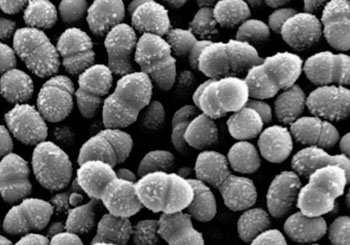A Unique Streptococcus Strain Now Dominates the Infection Landscape in the United Kingdom
By LabMedica International staff writers
Posted on 05 Aug 2015
British microbiologists have identified the mutations that were responsible for the dramatic increase in virulence of a Group A Streptococcus (GAS) variant that has now emerged as the dominant strain in the United Kingdom.Posted on 05 Aug 2015
Investigators at Imperial College London (United Kingdom) used whole-genome sequencing techniques to analyze changes in the genome of GAS genotype emm89. A sharp rise in the number of infections caused by this particular strain was observed from 1998 to 2009.

Image: Photomicrograph shows Streptococcus genotype emm89, which is typified by its lack of the hyaluronic acid capsule (Photo courtesy of Imperial College London).
Results of whole-genome sequencing revealed that although standard variable typing regions (emm subtype, tee type, sof type, and multilocus sequence typing [MLST]) remained unchanged, this unique subtype had undergone six distinct regions of homologous recombination across the genome compared to the rest of the sequenced emm89 population. Two of these regions affected known virulence factors, the hyaluronic acid capsule and the toxins NADase and streptolysin O.
Loss of the hyaluronic acid capsule was a particularly surprising finding, as it had been believed by microbiologists that the capsule was essential for GAS bacteria to cause invasive disease.
Senior author Dr. Shiranee Sriskandan, professor of medicine at Imperial College London, said, "This discovery was made possible thanks to the cooperation of our hospital diagnostic lab and the national reference lab, which helped us to spot a pattern locally and then study it nationally. We know very little about how group A Streptococcus is transmitted from person to person. We need to look into this more deeply and think about better ways to prevent transmission. Luckily, the new variant remains exquisitely sensitive to penicillin and related antibiotics. But we also need to think about whether our treatment strategies are as good as they can be."
The work was published in the July 14, 2015, online edition of the journal mBio.
Related Links:
Imperial College London













